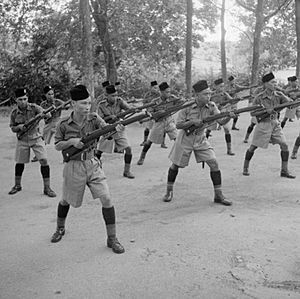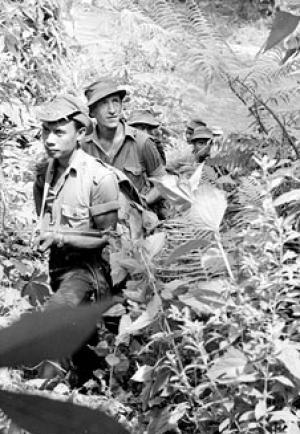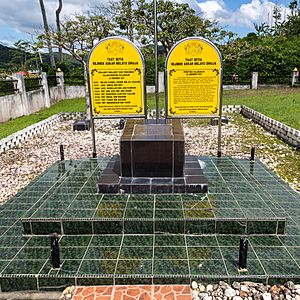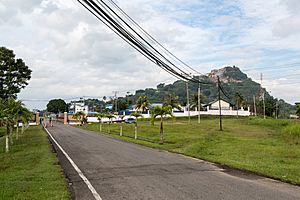Royal Malay Regiment facts for kids
Quick facts for kids Royal Malay Regiment |
|
|---|---|
| Rejimen Askar Melayu DiRaja | |
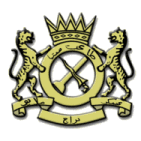
Cap Badge of the Rejimen Askar Melayu DiRaja
|
|
| Active | 23 November 1932 – present |
| Country | |
| Branch | |
| Type | Light Infantry |
| Role | Mechanised Infantry (three battalion) Light Infantry (21 battalions) Elite Parachute infantry (three battalions) |
| Size | 27 Battalion |
| Part of | |
| Nickname(s) | Malayan Gurkha |
| Motto(s) | Ta'at Setia (Loyal and True) |
| Colour of Beret | Rifle green |
| March | Berbuat Jasa |
| Engagements |
|
| Battle honours |
|
| Commanders | |
| Colonel in Chief | HRH Tuanku Sallehuddin ibni al-Marhum Sultan Badlishah, Sultan of Kedah |
| Notable commanders |
Lieutenant Adnan Saidi |
| Insignia | |
| Camp Gate Flag | |
The Royal Malay Regiment (Malay: Rejimen Askar Melayu DiRaja) is a very important part of the Malaysian Army. It is one of the two main infantry regiments. At one time, it had 27 groups, called battalions.
Today, three of these battalions are trained to jump from planes as paratroopers. They are part of Malaysia's quick-response army. Another battalion uses special vehicles and is called a mechanised infantry battalion. The rest are regular light infantry.
The 1st Battalion Royal Malay Regiment has a special job. They act as ceremonial foot guards for the King of Malaysia, the Yang di-Pertuan Agong. They are often joined by the Central Band of the Royal Malay Regiment. As the name suggests, only ethnic Malays can join this regiment.
| Top - 0-9 A B C D E F G H I J K L M N O P Q R S T U V W X Y Z |
History of the Royal Malay Regiment
The idea for the Malay Regiment started in 1920. Malay rulers asked the British to create an army group from local people. At that time, British and Indian soldiers protected the Malay States.
On November 23, 1932, the British War Office agreed to form the Malay Regiment. It would be a local regiment of the British Army. On January 23, 1933, a law was passed to create it. Money was also approved to buy land in Port Dickson for training new soldiers.
How the Regiment Started
The regiment began in 1933 with a small group called the 1st Experimental Company. This was a test to see how Malays would do in military training. On February 1, 1933, 25 young Malay men were chosen from 1,000 people who wanted to join.
This Experimental Company started on March 1, 1933, in Port Dickson. It had 25 recruits and was led by G. McBruce and Captain K. G. Exham.
On January 1, 1935, the Experimental Company officially became the Malay Regiment. It had 150 men. More soldiers were recruited quickly. Soon, 232 new recruits formed two rifle companies. They also had a headquarters group with machine guns, a signaling team, and a drum corps.
By January 1, 1938, the 1st Battalion Malay Regiment had many officers and soldiers. Training became more intense as war seemed likely. They practiced long marches and large-scale exercises. They also began training with mortars and anti-tank weapons.
In August 1941, a special platoon was formed to use Bren gun carriers. In March 1941, the regiment was allowed to grow to two battalions. These two battalions, along with a British battalion, formed the 1st Malaya Infantry Brigade. They played a big part in defending Malaya during World War II.
The first Malay Regiment unit to fight Japanese forces was Company A of the 2nd Battalion. They fought at Kampung Salak in Pengkalan Chepa, Kelantan. Even though they were outnumbered, they fought bravely before moving to Singapore.
Battle of Pasir Panjang Ridge
The first major fight for the Malay Regiment happened on February 13, 1942. Japanese soldiers attacked the Pasir Panjang Ridge in Singapore. B Company of the 1st Battalion, Malay Regiment, defended their spot. They faced heavy fire from Japanese troops, supported by artillery and tanks.
They were forced to move back, but the Japanese surrounded them. When they ran out of bullets, B Company fought fiercely with bayonets. Captain Yazid Ahmad took command as many officers were hurt. He died bravely leading his men. Some soldiers escaped, while others became prisoners.
Battle of Bukit Chandu
On February 14, the Japanese attacked again, very strongly. There was tough hand-to-hand fighting. The Malay Regiment's C Company was ordered to defend a new position, Bukit Chandu (Opium Hill). If the Japanese took this hill, they could easily reach British army supplies and hospitals.
Second Lieutenant Adnan Saidi and his men from C Company made a famous last stand at Bukit Chandu. This battle is remembered today. Adnan Saidi showed great courage and was killed fighting. His motto, "Biar Putih Tulang Jangan Putih Mata," means "it is better to die fighting than to live crying in regret." It means "Death Before Dishonour."
C Company was separated from another company by a burning canal. This stopped them from retreating. Their commander, Captain Rix, died early in the fight, so Second Lieutenant Adnan Saidi took over.
The Japanese tried a trick. They sent soldiers dressed as British Punjabi soldiers. But Second Lieutenant Saidi noticed that British soldiers march in threes, while Japanese soldiers march in fours. When the disguised soldiers got close, C Company opened fire, killing or wounding them.
Two hours later, the Japanese launched a huge attack. The Malay Regiment was greatly outnumbered and low on supplies. But they kept fighting. Reports say Lieutenant Saidi used a machine gun, and others fought with bayonets. He was badly hurt but refused to give up. He encouraged his men to fight to the very end. Adnan was later captured and tragically killed.
Some Malay Regiment officers who were prisoners of war were killed for refusing to join the Japanese army. They included Lieutenant Ariffin Hj Sulaiman, Lieutenant Abdul Wahid Jidin, Lieutenant Abdullah Saad, and Lieutenant Ibrahim Sidek. Lieutenant Ahmad Noordin and Lieutenant Muhammad Isa Mahmud also died earlier.
During the entire Malayan Campaign, especially in Singapore, the Malay Regiment lost 159 soldiers. This included British and Malay officers, and many other ranks. Many more were wounded.
Rebuilding After the War
After World War II, the British decided to expand the Malay Regiment. By 1950, they planned for it to have six battalions. The regiment would mainly help with security inside the country. By 1954, it had grown to seven battalions.
The Malayan Emergency
The Malay Regiment played a big role against communist fighters during the Malayan Emergency. Seven battalions served during this time. Soldiers used special rifles for jungle warfare.
In 1960, the regiment was given the 'royal' title. It became the Royal Malay Regiment. By 1961, it had 11 battalions. In 1963, seven years after Malaysia became independent, they received their special regimental flags.
Indonesian Confrontation
During the Indonesian Confrontation, the Royal Malay Regiment was sent to Sabah and Sarawak. On December 29, 1963, an outpost in Kalabakan was attacked by Indonesian "volunteers." Members of C Company of the 3rd Battalion, led by Major Zainal Abidin bin Haji Yaacob, fought back. They pushed the attackers away. Sadly, seven soldiers, including Major Zainal Abidin, were killed, and 16 others were wounded.
Serving the United Nations
The Royal Malay Regiment has also served in peacekeeping missions around the world.
Malayan Special Forces in Congo
The 4th Battalion Royal Malay Regiment was a key part of the Malayan Special Force in the Congo in 1960. They served under the United Nations. Later, the 6th, 7th, and 2nd Battalions also served there. The 2nd Battalion returned home on April 28, 1963.
Somalia Mission
As part of the UNOSOM II operation in Somalia, the 19th Battalion Royal Malay Regiment (Mechanised) arrived in Mogadishu on June 18, 1993. This battalion helped rescue US Army Rangers during the Battle of Mogadishu. They provided armored vehicles for the rescue team. One soldier, Private Mat Aznan, was killed, and four armored vehicles were destroyed during the rescue. He was promoted to Corporal after his death.
Bosnia and Herzegovina Mission
The 23rd Battalion Royal Malay and 3rd Armour formed MALBATT I. They were part of the United Nations Protection Force in September 1993. Other battalions also served in Bosnia later, helping with peacekeeping efforts.
Regimental Crest
The Royal Malay Regiment's crest shows two tigers holding an Oriental Crown. Inside a circle, there is a kris (a traditional dagger) and its scabbard. The regiment's motto, "Ta'at Setia," is written in Jawi script. It means "Loyal and True." Major G. McI. S. Bruce and Captain K. G. Exham, who helped start the regiment, designed the crest.
Three colors were chosen for the crest:
- Green: This is a Muslim color.
- Yellow: This represents Malay royalty.
- Red: This shows the influence of the British Army.
Royal Guards
The Royal Malay Regiment guards the National Palace in Kuala Lumpur.
Battle Honours
The regiment has earned many battle honours for its bravery and service:
- Second World War:
- Tanah Melayu 1941–42
- Singapura 1942
- Darurat 1948–1960
- Konfrontasi 1963–1965 – Confrontation with Indonesia
- Battle of Mogadishu, Somalia 1993–1995
- Bosnia 1993–1998
- Namibia 1989–1990
- Cambodia 1992–1993
- Congo 1960–1963
- East Timor - Operation Astute 2006
- Lahad Datu 2013
UN Peacekeeping Missions
The Royal Malay Regiment has also served in many United Nations peacekeeping missions:
- Democratic Republic of the Congo 1960–1963
- Namibia 1989–1990
- Cambodia 1992–1993 (UNTAC)
- Bosnia and Herzegovina 1993–1998
Alliances with Other Regiments
The Royal Malay Regiment has special alliances with other army regiments from different countries:
 Australia – The Royal Australian Regiment
Australia – The Royal Australian Regiment United Kingdom – The Royal Anglian Regiment; 1st Bn
United Kingdom – The Royal Anglian Regiment; 1st Bn United Kingdom – The Duke of Lancaster's Regiment (King's Lancashire and Border); 2nd Bn
United Kingdom – The Duke of Lancaster's Regiment (King's Lancashire and Border); 2nd Bn United Kingdom – The Royal Welsh; 4th Bn
United Kingdom – The Royal Welsh; 4th Bn United Kingdom – The Royal Scots Borderers; 5th Bn
United Kingdom – The Royal Scots Borderers; 5th Bn United Kingdom – The Rifles; 6th Bn
United Kingdom – The Rifles; 6th Bn United Kingdom – The Royal Gurkha Rifles
United Kingdom – The Royal Gurkha Rifles New Zealand – The Royal New Zealand Infantry Regiment; 7th Bn
New Zealand – The Royal New Zealand Infantry Regiment; 7th Bn
Battalions of the Royal Malay Regiment
The Royal Malay Regiment has 27 battalions in total.
- 21 are standard light infantry battalions.
- Two are mechanized infantry battalions.
- Three are parachute infantry battalions.
- One is a support unit.
1st Battalion Royal Malay Regiment
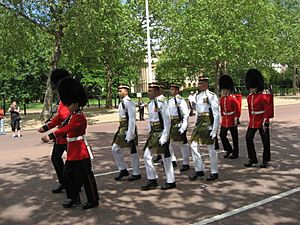
The 1st Battalion Royal Malay is the oldest infantry battalion in the Regiment. This was also the battalion where Lieutenant Adnan Bin Saidi served. In 2008, the 1st Battalion made history. They became the first all-Muslim unit to guard Buckingham Palace in London. They were also the first guard from a nation that was not a Commonwealth realm.
Their main job is ceremonial duties. They represent Malaysia's defense during important events like state visits. They guard the National Palace in Kuala Lumpur and the Ministry of Defence Building.
5th Battalion Royal Malay Regiment
The 5th Battalion Royal Malay Regiment has an alliance with the King's Own Scottish Borderers Regiment (KOSB) from the British Army. This alliance started during the Malayan Emergency. The 5th Battalion keeps some KOSB traditions. For example, the shoulder patch of their officers and men uses the KOSB regimental colors.
The 5th Battalion also has a bagpipe platoon. This tradition began in 1953 when a Scottish officer helped train their pipers. To this day, the bagpipe platoons of both battalions keep their alliance strong. The 5th Battalion's bagpipe platoon has even been invited to the Edinburgh Festival in Scotland.
6th Battalion Royal Malay Regiment
The 6th Battalion, Royal Malay Regiment, was formed on May 1, 1952. It moved to Quetta Camp in Kluang, Johor, on November 3, 1952. British officers helped form the command team at first.
Over time, Malay officers replaced the British ones. By early 1954, most officers in the battalion were Malay. Jeneral (Rtd) Tun Ibrahim Ismail was the first Malay Commanding Officer of the battalion. He later became the first Malay Chief of the Malaysian Armed Forces.
This battalion is a standard infantry unit. It has taken part in joint exercises with the New Zealand Army. It also served in The Congo as part of the Malayan Special Force under the United Nations.
7th Battalion Royal Malay Regiment
The 7th Battalion Royal Malay Regiment is a mechanized unit. This means they use special vehicles. It is allied with the Royal New Zealand Infantry Regiment from New Zealand. It is currently based at Kukusan Camp in Tawau, Sabah.
17th Battalion Royal Malay Regiment
The 17th Battalion, Royal Malay Regiment (17 RAMD), was formed on August 1, 1970. It is an elite force of paratroopers. They are part of the Malaysian Army's 10th Parachute Brigade. In 1994, the 17th PARA did a fast deployment exercise. This exercise involved taking back Langkawi International Airport from an invading force.
27th Battalion Royal Malay Regiment
The 27th Royal Malay Regiment (27 RAMD) is a newly formed standard infantry battalion. It will be part of the 5th Infantry Brigade in Sabah, Malaysia.
Notable People of the Regiment
Lieutenant Adnan Bin Saidi
Adnan Saidi led the 42-strong No.7 Platoon of 'C' Company, 1st Battalion of the Malay Regiment. They defended Bukit Chandu (Opium Hill) from February 12–14, 1942. Even though they were greatly outnumbered, Adnan refused to surrender. He told his men to fight until the end. They held off the Japanese for two days, despite heavy attacks and low supplies.
Adnan was shot but kept fighting. After the battle was lost, he was captured by Japanese soldiers. He was tragically killed. Adnan shows the bravery of the Malay Regiment. Because of his actions, he is seen as a hero by many Malaysians and Singaporeans today.
Captain Hamid Bin Awang
Captain Hamid Bin Awang led "D" Company of the 2nd Royal Malay Regiment. They were on a mission to find and destroy communist guerrillas. On April 7, 1973, Captain Hamid and his company found a guerrilla camp. He led an attack on the camp.
During the fight, a guerrilla tried to shoot one of Captain Hamid's men. Captain Hamid quickly rushed to the guerrilla and hit him with his grenade launcher. Captain Hamid's company killed three enemies and captured their weapons. Captain Hamid was awarded a special medal for his bravery.
See also
- Royal Ranger Regiment (Rejimen Renjer DiRaja)
- The Royal Malay Regiment during the changing of the guard in London


